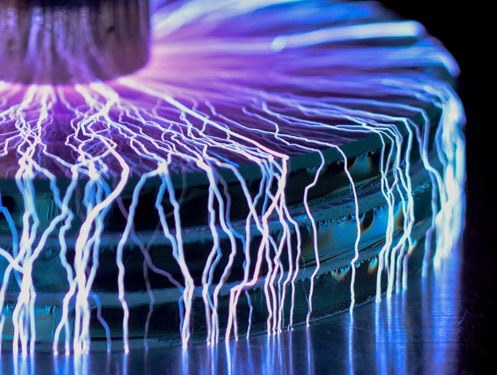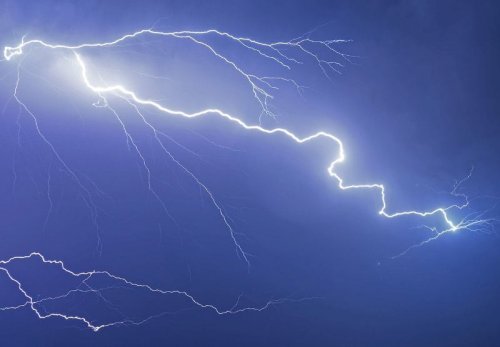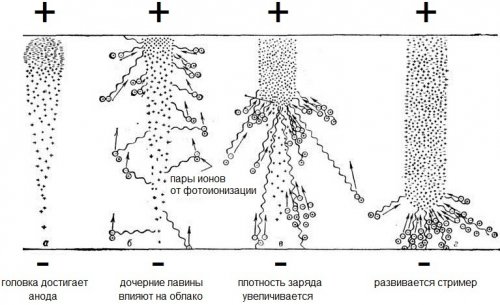Stream theory of the electrical breakdown of gases
The word "flow" itself is translated as "flow". Accordingly, a «streamer» is a set of thin branched channels through which electrons and ionized gas atoms move in a kind of flow. In fact, the streamer is a precursor to a corona or spark discharge under conditions of relatively high gas pressure and relatively large electrode spacing.

The branched glowing channels of the streamer lengthen and eventually overlap, close the gap between the electrodes — continuous conductive filaments (sparks) and spark channels are formed. The formation of a spark channel is accompanied by an increase in the current in it, a sharp increase in pressure and the appearance of a shock wave at the channel boundary, which we hear as a crackling of sparks (thunder and lightning in miniature).
The streamer head, located at the front of the channel thread, glows the brightest. Depending on the nature of the gaseous medium between the electrodes, the direction of travel of the streamer head can be one of two things, thus distinguishing anodic and cathodic streamers.
In general, a streamer is a stage of destruction that lies between a spark and an avalanche. If the distance between the electrodes is small and the pressure of the gaseous medium between them is low, then the avalanche stage bypasses the streamer and goes directly to the spark stage.
Unlike the electron avalanche, the streamer is characterized by a high speed (about 0.3% of the speed of light) of the propagation of the head of the streamer to the anode or cathode, which is many times higher than the speed of electron drift simply in an external electric field.
At atmospheric pressure and at a distance of 1 cm between the electrodes, the propagation speed of the head of the cathode streamer is 100 times higher than the speed of an electron avalanche. For this reason, the streamer is considered as a separate stage of preliminary breakdown of an electric discharge into a gas.
Heinz Ratner, experimenting in 1962 with a Wilson camera, observed the transition of an avalanche into a streamer. Leonard Loeb and John Meek (as well as Raettner independently) proposed a streamer model that explains why the self-sustaining discharge forms at such a high rate.
The fact is that two factors lead to a high speed of movement of the streamer head. The first factor is that the gas in front of the head is excited by resonant radiation, which leads to the appearance of the so-called. Free electrons in seeds during the associative ionization reaction.
Seed electrons are formed along the channel more efficiently than would occur in direct photoionization.The second factor is that the electric field intensity of the space charge near the head of the streamer exceeds the average electric field intensity in the gap, thereby achieving a high ionization rate during the propagation of the streamer front.
The figure above shows a diagram of the formation of a cathode streamer. When the head of the electron avalanche reached the anode, behind it there was still a tail in the interelectrode space in the form of a cloud of ions. Here, due to the photoionization of the gas, daughter avalanches appear, which attach to this cloud of positive ions. The charge becomes more and more dense, and in this way a self-propagating flow of positive charge is obtained - the streamer itself.
Theoretically, at this point in the space between the electrodes, where the avalanche turns into a streamer, at a certain moment there is a point where the total electric field (the electric field created by the electrodes and the space charge field of the streamer head) disappears. This point is assumed to lie along the axis of the avalanche. Basically, the streamer front is a nonlinear ionization wave, a space charge wave that arises in free space as a combustion wave.
For the formation of the front of the cathode streamer, the emission of radiation outside the boundaries of the gap between the electrodes is essential.At the moment when the electric field strength in the streamer head reaches a critical value, which corresponds to the beginning of electron leakage, the local equilibrium between the electric field and the electron velocity distribution is disturbed, which in general greatly complicates the streamer model of electric breakdown of gas.


